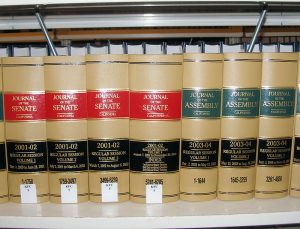
Journals of the California Legislature. (Photo: Wikipedia)
Considerations in Drafting California Legislation – Part II
Technical or legal jargon should be limited, except where necessary
By Chris Micheli, April 29, 2020 6:30 am
This is Considerations in Drafting California Legislation – Part II; Part I is here.
Continuing with our exploration of drafting legislation in California, there are a number of considerations to address when it comes time to working on bills and amendments. We should generally begin drafting by keeping at the forefront the desire to fulfill the “plain meaning” rule. This means that your bill drafting needs to use simplistic language, and technical or legal jargon should be limited, except where necessary.

In drafting legislation, we should try to use ordinary language that is generally known and understood by the average person. The language we use should be clear and brief, and limit any unnecessary, confusing or redundant words. Also, think about when and where it is appropriate to define terms used in your drafting. While sometimes it is necessary or desirable to be vague, we should try to avoid it as much as possible.
It is also important to recognize the proper use of terminology. The following are some examples:
What is the difference between the terms “means” and “includes”? According to the U.S. House of Representatives Office of Legislative Counsel (OLC), the term “means” is exclusive, while the term “includes” is not. For example, if the statute says, “the term __ means __,” then it cannot include anything else. On the other hand, if the statute says, “the term __ includes __,” then it could include something else.
What is the difference between “shall” and “may”? According to the U.S. House of Representatives OLC, the term “shall” means that it specifies a required action, while the term “may” means that a permissible action is specified, but it is not required. On the other hand, “may not” is also mandatory and is often used for denying a right or power.
In general, bill drafters use a singular word, rather than the plural form, because sometimes ambiguity is created by plural words. An example of this by the U.S. House of Representatives OLC is “drivers may not run a red light” versus “a driver may not run a red light.” In the first instance, one interpretation is that a violation only occurs if multiple drivers run a red light. That ambiguity is eliminated if the singular term is used instead of the plural term.
Another example is understanding the differences between these similar words and which one is appropriate for your bill draft: Assure, which means to create confidence. Ensure, which means to make certain. Insure which means to provide insurance.
In California, there are a number of substantive drafting considerations which I have covered in earlier articles. Some of these items include:
- Single subject rule (i.e., a bill cannot deal with multiple subjects)
- Germaneness (i.e., are any amendment drafted for the bill not germane to the current contents of the bill?)
- Urgency clauses (i.e., statutes that take effect immediately require specific language in the bill to be utilized)
- General versus special statutes (in rare instances, a special statute may be required due to unique circumstances and specific language in the bill must be utilized)
- Special rules around tax measures (tax levies and tax increase measures generally require certain bill language to be used)
- Constitutional concerns — both state and federal
In “putting pen to paper,” the bill drafter needs to think about the goal or intent of the proposed legislation. It is important to understand the public policy goal that the bill author is trying to achieve. Based upon this feedback, and any materials you receive from the author’s office, you may be required to conduct research to examine whether there are similar statutes in current law, or perhaps at the federal or other state levels.
It may also be necessary to conduct research on the public policy issues being addressed by the legislation in order to better understand how to address the author’s intent when you are drafting the legislation. After your research and review of current law has concluded, it is time to write an initial draft of the bill.
Based upon where to place the bill in existing law (i.e., which Code and which division or chapter within that Code), determine how other statutes in this area of the Code are drafted. Can you use already defined terms?
Once you have completed your initial draft, it would be a good approach to set aside that draft for a few hours or a day or two, assuming you have sufficient time to take a break from it. When you revisit your draft, try to poke holes in the language. Did you now define or cross-reference terms? Are there any ambiguities in the language? Have you taken into account the general rules of statutory construction that a court will utilize if it ultimately reviews the statute that you drafted?
- Frequently Asked Questions About Ethics Training for Local Agencies - April 24, 2024
- Frequently Asked Questions about Privileges of Voters in California - April 23, 2024
- Does a Bill Need Statutory Construction Guidance? - April 22, 2024


